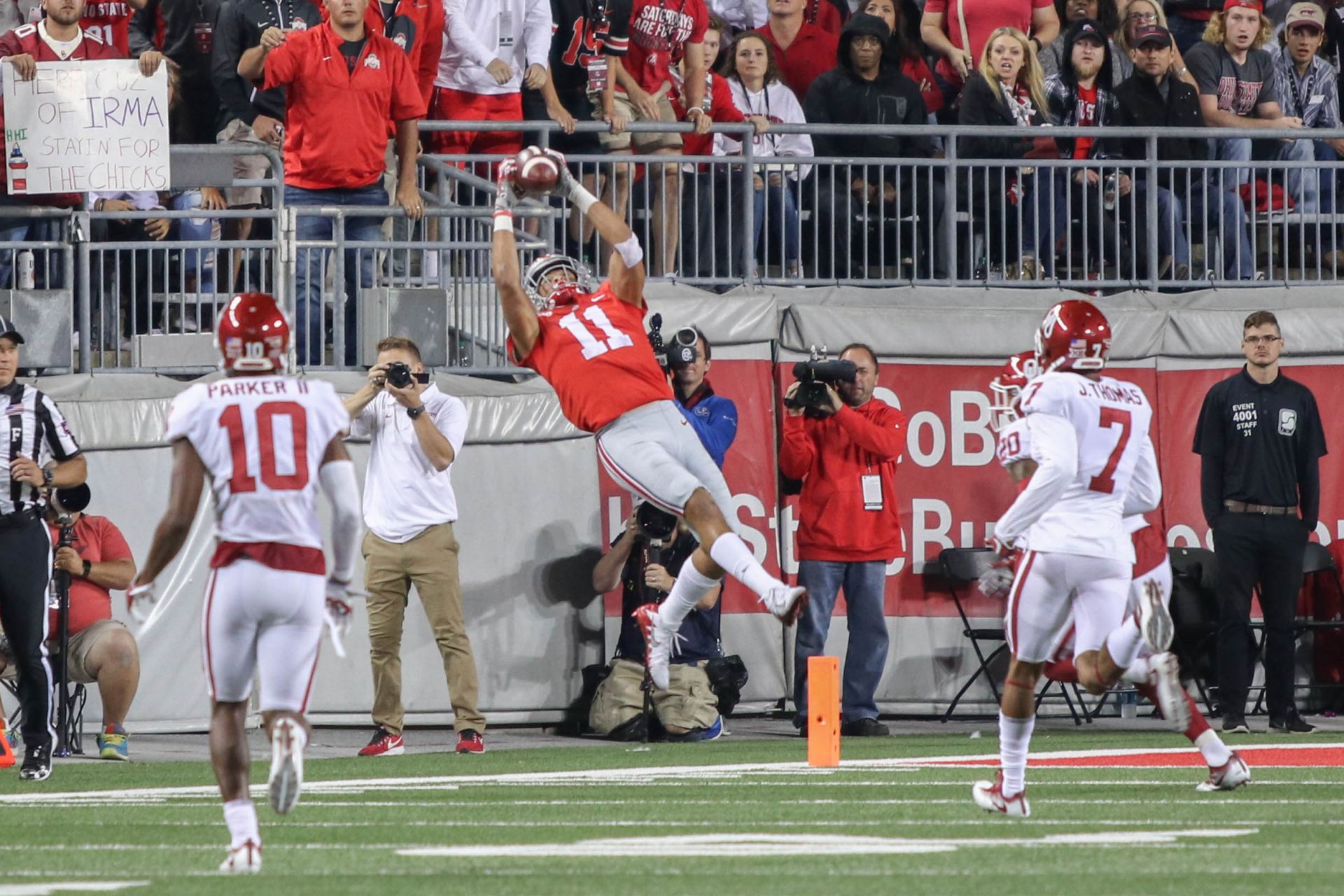
Senior quarterback J.T. Barrett (16) throws a pass on the run during the Ohio State- Oklahoma game on Sep. 9. Credit: Jack Westerheide | Photo Editor
No. 2 Ohio State (1-1) dropped the first game of its season Saturday, losing in convincing fashion to No. 5 Oklahoma (2-0) as the Sooners rolled to a 31-16 victory. Here are our takeaways to help explain the Buckeyes’ anemic passing game.
What went wrong through the air?
In the first half, redshirt senior quarterback J.T. Barrett had just 25 passing yards. Things didn’t get much better. The first three-time team captain in team history completed 19-of-35 passes for 183 yards, was sacked three times and threw an interception at one of the most inopportune times possible.
Nothing went right for Barrett and the offense which gained 350 yards, 140 less than their opponent.
“Offense was bad,” Meyer said. “So we’re going to do what we do and that’s go back to work as hard as we possibly can, starting somewhat tonight and tomorrow and figure this thing out.”
After Saturday night’s game, the outlook on the passing game seems as bleak as it has been since Barrett was named starter in 2014.
Last week, some things seemed to be improved from an offense that sputtered at the end of the 2016 season. Barrett earned Big Ten co-Offensive Player of the Week as he finished 20-for-35 for 304 yards, including three touchdowns. Though he didn’t connect on any deep balls, he hit two pass plays for more than 50 yards.
This week, he didn’t complete a pass more than 31 yards. Wideout Terry McLaurin had a ball drop through his outstretched hands in the end zone in the first half, which would have been the longest pass of the game.

Junior wide receiver Terry McLaurin (83) attempts to catch a pass during the Ohio State- Oklahoma game on Sep. 9. Credit: Jack Westerheide | Photo Editor
Things went from bad to worse early in the fourth quarter when Barrett followed up an Oklahoma touchdown by throwing an interception on the first play of Ohio State’s drive, giving the Sooners great field position.
“We were challenged first half against Indiana, didn’t play very well and played very well in the second half,” Meyer said. “This game we didn’t play very well. So we’ll go back at it and it’s a long, long season.”
After the game, Barrett said the offense isn’t broken and has never been broken. He admitted he and the team played poorly, but said he understands the season has just begun and the team will be able to grow.
“We’ve worked extremely hard at [the passing game],”Meyer said. “It wasn’t good tonight. We’ve got to get the damn thing fixed, and we will.”
No QB change
Despite Barrett’s shaky play and questions as to whether he should be the leader of the offense, Meyer shut down any uncertainty as to whether he would be making a quarterback change with just one word: “No.”
The head coach didn’t even allow the question to be finished before his emphatic answer.
“I think he’s confident in me,” Barrett said when asked about his coach’s faith in him. “I understand that I’ve been here before. Back in 2014, lost to Virginia Tech and I was 9-of-28. So, I’ve been here before. I didn’t play that bad, but I definitely didn’t play as far as putting us in the best situation to win.”
Meyer and his quarterback each mentioned that when a team loses, the quarterback gets overly blamed and when it wins, the signal-caller gets too much praise. Meyer wanted to equally distribute the criticism across the offense, mentioning that he needs to rewatch the film to fully critique specific players.
“I’m going to make it perfectly clear, there’s not a bullseye on J.T. Barrett. It’s part of the system and a group that have to get better,” Meyer said.
No “flow” in the offense
After Ohio State’s loss to Oklahoma, Meyer didn’t have the answers to many questions asked at his postgame press conference.

Junior H-back Parris Campbell attempts to catch a pass during the Ohio State- Oklahoma game on Sep. 9. Credit: Jack Westerheide | Photo Editor
He said he had to re-watch the game. However, one thing was clear to the head coach: The offensive rhythm did not exist Saturday and has not for many games dating back to last season.
“We gotta go beat Army is what we have to do and get on a roll,” Meyer. “That’s what we have to do. You’ve seen a roll around here a few times. So that’s what has to happen.”
Meyer reiterated himself, saying the offense needs to find a flow. The offense used six plays or less on five of 11 drives. Ohio State managed drives of more than 45 yards just twice while Oklahoma drove that distance six times Saturday.
Co-offensive coordinators Kevin Wilson and Ryan Day were hired in January to rework an offense that began to get stale in the latter portion of last season. Not only has the offense struggled through two games, there are no notable changes that have made large impacts on the offense.
Without long, extended drives, Ohio State’s discombobulated, Barrett-led offense needed to hit big plays for large chunks of yardage. But lacking a threatening deep ball, it seems unlikely that the offense will be able to rely on big plays to jump-start itself.
Still no go-to threats
H-back Parris Campbell and wide receiver Johnnie Dixon each broke plays that gained more than 50 yards against Indiana. But both receivers were non-factors against the Sooners. Campbell caught three passes for 27 yards, and Johnnie Dixon caught a single pass, on the Buckeyes’ final drive, for 12 yards.
Unlike in Week 1, not a single Ohio State receiver even scored a touchdown. The biggest play of the game was made by wideout Austin Mack, who snagged a 31-yard pass to put his team on the 7-yard line.

Sophomore wide receiver Austin Mack (11) catches a pass during the Ohio State- Oklahoma game on Sep. 9. Credit: Jack Westerheide | Photo Editor
But the Buckeyes settled for a field goal, and the sophomore exited the game with an apparent injury. In fact, this was his only catch of the game and he led Ohio State in receiving yards until H-back K.J. Hill caught a 17-yard pass on the game’s final play.
Hill led Ohio State with five catches for 44 yards. But he was anything but the security blanket Barrett needed. Especially near the goal line, the Buckeyes struggled to finish drives off with touchdowns. Ohio State scored on all four red zone opportunities, but settled for field goals on three occasions.
Facing zone in practice a negative factor?
Though the cornerbacks have struggled in the first two games of the season, cornerbacks coach Kerry Coombs and his unit are known for staunch, man-to-man coverage. That has led to multiple cornerbacks — including Marshon Lattimore and Gareon Conley last year — being drafted in the first round of the NFL draft.
After Saturday’s game, Barrett referenced the zone coverage looks he and the offense were matched up against on multiple occasions. He mentioned that the looks the Buckeyes’ defense has given him in practice might not prepare him well for different types of defenses.
“When we’re talking about it in the preseason, going against our defense is a lot more man coverage,” Barrett said. “We don’t see a lot of spot coverage going against our defense.”
Given the lack of experience preparing against zone coverage, Barrett said he needs to learn to trust his pass-catchers more when facing that style of defense. After the game, the quarterback said he was late releasing the ball because he doesn’t have the complete trust he needs — yet.


